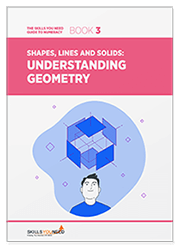Introduction to Angles
See also: Circles and Curved ShapesOnce you have mastered the idea of points, lines and planes, the next thing to consider is what happens when two lines or rays meet at a point, creating an angle between them.
Angles are used throughout geometry, to describe shapes such as polygons and polyhedrons, and to explain the behaviour of lines, so it’s a good idea to become familiar with some of the terminology, and how we measure and describe angles.
What is an Angle?
Angles are formed between two rays extending from a single point:

Angles are commonly drawn as an arc (part of a circle), as above.
Properties of Angles
Angles are measured in degrees, which is a measure of circularity, or rotation.
A full rotation, which would bring you back to face in the same direction, is 360°. A half-circle is therefore 180°, and a quarter-circle, or right angle, is 90°.

Two or more angles on a straight line add up to 180°. In the diagram above, the circle to the left is split into three sectors the angles of the green and white sectors are both 90°, adding up to 180°.
The figure to the right shows that angles a and b also add up to 180°. When you look at the diagram like this, it’s easy to see this, but it’s also surprisingly easy to forget in practice.
Naming Different Angles
An angle less than 90° is said to be acute, and one greater than 90° but less than 180° is obtuse.
An angle of exactly 180° is said to be straight. Angles greater than 180° are called reflex angles.
Different angles can be demonstrated on a clock face. The hour hand of the clock moves round as time passes through the day. The angle of the rotation is highlighted in green.

Opposite Angles: Intersecting Lines
When two lines intersect, the opposite angles are equal. In this case, not only are a and a the same, but, of course, a and b add up to 180°:
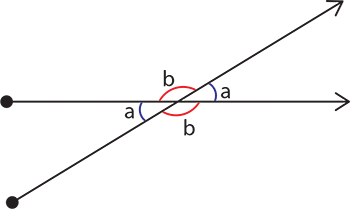
Intersections with parallel lines: a bit of a special case
Our page An Introduction to Geometry introduces the concept of parallel lines: lines that go on forever side by side and never cross, like railway lines.
The angles around any lines intersecting parallel lines also have some interesting properties.
If two parallel lines (A and B) are intersected by a third straight line (C), then the angle at which the intersecting line crosses will be the same for both parallel lines.
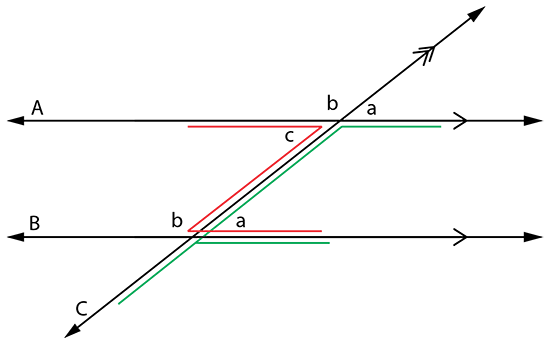
The two angles a and the two angles b are said to be corresponding.
You will also immediately see that a and b add up to 180°, since they are on a straight line.
Angle c, which you will realise from the previous section is identical to a, is said to be alternate with a.
Z and F Angles
c and a are called z-angles, because if you follow the line from the top of c to the bottom of a, it forms the shape of a z (in red in the diagram above).
a and a are said to be F-angles, because the line forms an F shape from the bottom of the upper angle a down and around to the bottom of the lower angle a (in green in the diagram)
Measuring Angles
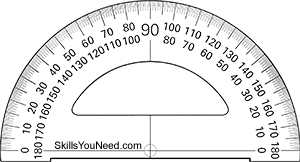
A protractor is commonly used to measure angles. Protractors are usually circular or semi-circular and made of transparent plastic, so that they can be placed over shapes drawn on a piece of paper, allowing you to take a measurement of the angle.
This example demonstrates how to use a protractor to measure the three angles of a triangle, but the same method applies to other shapes or any angles that you want to measure.
- Line up the central mark on the base of your protractor with the vertex, or point at which the lines meet. The triangle has three vertices, one for each angle to measure.
- Most protractors have a bi-directional scale meaning that you can take a measurement in either direction. Make sure you use the correct scale – you should be able to tell easily if your angle is greater than or less than 90° and therefore use the right scale. If you’re not sure, take a quick look back to our section on naming angles.
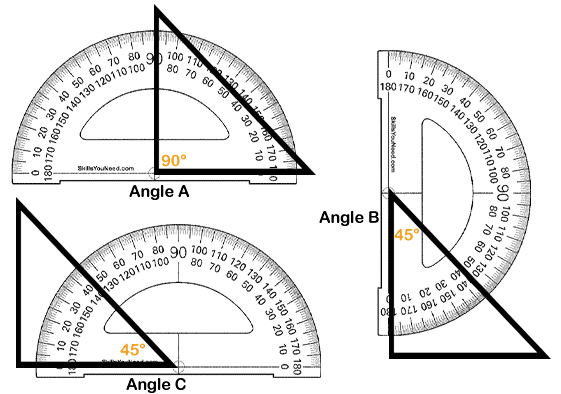
In this example the recorded angles are A=90° B=45° and C=45°.
Polygons are often defined by their internal angles, and the total of the internal angles depends on the number of sides. For example, the internal angles of a triangle always add up to 180°. For more about this, see our page on Polygons.
Degrees or Radians?
When we need to measure or describe an angle, we usually use ‘degrees’ as the unit of measurement. However, very occasionally, you may find angles referred to in radians.
The radian is the Standard International (SI) unit of measurement for angles and is used in many areas of science and mathematics.
We said above that the full rotation of angles through a circular arc is equal to 360°. It is also equal to 2π radians, where π (pi) is a special number equalling (approximately) 3.142 (there is more about π in our page on Special Numbers and Concepts).
One radian is equal to 360/2π = 57.3°. We also use pi when we need to calculate the area or circumference of a circle, or the volume of a sphere (and there is more about this in our page on Curved Shapes).
Further Reading from Skills You Need
Understanding Geometry
Part of The Skills You Need Guide to Numeracy
This eBook covers the basics of geometry and looks at the properties of shapes, lines and solids. These concepts are built up through the book, with worked examples and opportunities for you to practise your new skills.
Whether you want to brush up on your basics, or help your children with their learning, this is the book for you.
Moving on…
Once you understand about angles, and how to measure them, you can put this into practice with polygons and polyhedrons of all kinds, and also use your knowledge to calculate area (there is more about this in our page on Calculating Area).


